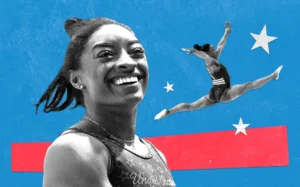A writer who’s covered Simone Biles since 2013 expects more greatness at the Paris Olympics from the most decorated gymnast of all time.

The first time I saw Simone Biles in competition, she didn’t win. This, it would turn out, was an exceedingly rare experience, because winning has become synonymous with the Texan—it’s something she’s done more of than any other gymnast who ever tiptoed across a balance beam.
Many gymnastics fans were introduced to Biles when she was already in the middle of her first gold medal run, at the 2013 world championships in Antwerp, Belgium. Others might have heard of her after she hoisted gold at the 2015 worlds in Glasgow. That competition wrapped up less than a year before the 2016 Olympics were set to begin. By the time the Rio Games began, even casual fans understood that Biles’s eventual win in the all-around was considered a foregone conclusion. Nearly everyone who watched her compete in Brazil expected to witness greatness—and so has just about everybody who’s seen her compete since then.
But back in the spring of 2013, at the American Cup in Worcester, Massachusetts, Biles was a fifteen-year-old newcomer who had just aged into the senior ranks. As a junior gymnast, she had done well but hadn’t been a standout. It wasn’t until her final junior seasons that she started to win significant titles, and those were only of the domestic variety. Her senior debut in Worcester was Biles’s first competition at the international level.
I’ll admit that I knew very little about her when I sat down in the media section at that event. I knew some basics: her age; that she was from Spring, Texas, just outside Houston; her placement at the previous year’s junior nationals. (The year before, 2012, I had been exclusively focused on the athletes who were old enough for 2012 Olympics, and I hadn’t paid much mind to the gymnasts coming up behind that group.)
I was seated vaultside, at the ideal angle to view Biles’s Amanar (a vault move named after Romanian gymnast Simona Amânar). Though it had been introduced in 2000, only a handful of gymnasts had competed it over the next dozen or so years, and even fewer executed it well. Biles clearly fell into the latter camp. Her block was clean, and it lifted her high into the air even before she started wrapping in the two and a half clean twists. McKayla Maroney had performed that skill to near perfection at the previous year’s London Olympics, and here Biles was doing it almost as well as Maroney.
On bars, her weakest event, Biles was tidy but not a standout. Her nerves and inexperience shone through on beam, where she fell. But then came floor, the event that would become one of her signatures. There, she demonstrated her tumbling prowess and her immense promise. In the years since the 2013 American Cup, when I told friends about seeing Biles for the first time, I always brought up her tucked double-double tumbling pass. I had never before seen anyone twist so quickly in such a tight tuck position and complete the rotations with that much space beneath them. “You could drive a truck under her,” I’d say to describe the vertical height Biles attained at the peak of her somersaults.
But my writing about that moment, at that moment, used tamer language: “When you watch the 15-year-old on all four events, you’re struck by how much potential Biles has, and she’ll only improve over the next couple of years if she avoids injury. . . . Biles’s tumbling, which would be extremely difficult even for more experienced gymnasts, seems easy for her, and she’ll certainly upgrade it in the near future.”
Watching Biles in this early period of her career felt like watching a new TV show from its pilot, before streaming made it possible to binge-watch. The episodes were released over the course of several weeks, months, or years, and it took a while for the story to unfold. With Biles, you got to be continually surprised by her literal twists and turns.
Of this early period, Biles, in the new Netflix series Simone Biles Rising, observed that this was the last time she was considered an underdog. By the end of 2013, she had picked up her first all-around gold at the world championships, and from then on, she was expected to win every competition she entered. She seemed almost wistful recalling those early days, when the career in front of her was defined by endless possibilities and few expectations.
But at some point, possibilities became probabilities. Biles stopped being simply a contender or a favorite and instead became a sure bet. I believe this happened somewhere between her win at the 2013 worlds and the following year’s world championships, in China. I attended that competition, in Nanning, and I recall nearly everyone there believing Biles was unbeatable. I agreed, but I was taken aback by how quickly the consensus had formed. It took all of one year for the gymnastics community to view Biles as the rest of the world would once it became aware of her—as an inevitability.
There’s a chance that Paris 2024, Biles’s third Games, will also be her final Olympic hurrah, though she hasn’t said so herself. Unlike in the lead-up to 2020, when she declared many times that she would be done after Tokyo (she softened her stance as the postponed Games approached), she has remained mum on the topic this time around. Still, that hasn’t stopped some in the media from announcing her retirement for her.











